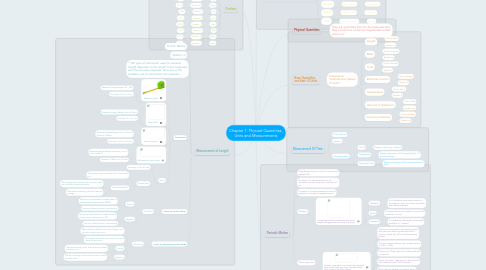
1. Prefixes
1.1. They are used to express physical quantities that are either very large or very small.
1.2. Prefixes are based on the SI unit of the particular physical quantity.
1.3. Giga
1.3.1. Symbol: G
1.3.1.1. 10^9
1.4. Mega
1.4.1. Symbol: M
1.4.1.1. 10 ^6
1.5. Kilo
1.5.1. Symbol: k
1.5.1.1. 10^3
1.6. Deci
1.6.1. Symbol: d
1.6.1.1. 10^-1
1.7. Centi
1.7.1. Symbol: c
1.7.1.1. 10^-2
1.8. Milli
1.8.1. Symbol: m
1.8.1.1. 10^-3
1.9. Micro
1.9.1. Symbol: μ
1.9.1.1. 10^-6
1.10. Nano
1.10.1. Symbol: n
1.10.1.1. 10^-9
2. Measurement of Length
2.1. SI Unit: Metres
2.2. Symbol: m
2.3. * The type of instrument used to measure length depends on the length to be measured and the accuracy required. Accuracy is the smallest unit an instrument can measure.
2.4. Instruments
2.4.1. Measuring Tape
2.4.1.1. Measured Length Range: 0m - 10m
2.4.1.2. Accuracy: 0.1cm or 1 mm
2.4.2. Metre Rule
2.4.2.1. Measured Length Range: 0cm to 100cm
2.4.2.2. Accuracy: 0.1 to 1 mm
2.4.3. Vernier Calipers
2.4.3.1. Measured Length Range: 2cm to 10cm or 20mm to 100mm
2.4.3.2. Accuracy: 0.01cm or 0.1mm
2.4.4. Micrometer Screw Gauge
2.4.4.1. Measured Length Range: Less than 3 cm or 0mm to 30mm
2.4.4.2. Accuracy: 0.001cm or 0.01mm
2.4.5. Rulers
2.4.5.1. Accuracy: 0.1cm or 1mm
2.4.5.2. Parallax Error
2.4.5.2.1. The incorrect way of reading from a ruler leads to it
2.4.5.2.2. How to prevent it?
2.5. +More on Vernier Caliper
2.5.1. Zero Errors
2.5.1.1. Positive
2.5.1.1.1. Before any measurement is made, there is already some measurement MORE.
2.5.1.1.2. Solution: Minus this error to the reading.
2.5.1.2. Negative
2.5.1.2.1. Before any measurement is made, there is already some measurement LESS.
2.5.1.2.2. Solution: Add this error to the reading
2.6. + More on Micrometer Screw Gauge
2.6.1. Zero Errors
2.6.1.1. When reading a Micrometer Screw Gauge, error can occur due to zero error.
2.6.1.2. Thus before we use the instrument, we must check for zero error.
2.6.1.3. Positive
2.6.1.3.1. The zero marking on the thimble scale is below the datum line.
2.6.1.4. Negative
2.6.1.4.1. The zero marking on the thimble scale is above the datum line.
3. Physical Quantities
3.1. They are quantities that can be measured and they consist of a numerical magnitude/number and a unit.
4. Base Quantities and their SI Units
4.1. SI stands for "International System of Units"
4.1.1. Length
4.1.1.1. SI Unit: Metre
4.1.1.2. Symbol: m
4.1.2. Mass
4.1.2.1. SI Unit: Kilogram
4.1.2.2. Symbol: kg
4.1.3. Time
4.1.3.1. SI Unit: Seconds
4.1.3.2. Symbol: s
4.1.4. Electrical Current
4.1.4.1. SI Unit: Ampere
4.1.4.2. Symbol: A
4.1.5. Temperature
4.1.5.1. SI Unit: Kelvin
4.1.5.2. Symbol: K
4.1.6. Amount of Substance
4.1.6.1. SI Unit: Mole
4.1.6.2. Symbol: mol
4.1.7. Luminous Intensity
4.1.7.1. SI Unit: Candela
4.1.7.2. Symbol: cd
5. Derived Quantities and their SI Units
5.1. They are quantities derived from two or more base physical quantities
5.2. Area
5.2.1. Length × Width
5.2.1.1. m ²
5.3. Volume
5.3.1. Length × Width × Height
5.3.1.1. m³
5.4. Density
5.4.1. Mass ÷ Volume
5.4.1.1. kg/m³ or kgm-³
5.5. Speed
5.5.1. Distance ÷ Time
5.5.1.1. m÷s or ms-²
5.6. Force
5.6.1. Mass × Acceleration
5.6.1.1. kg m s-²
6. Measurement Of Time
6.1. SI Unit: Second
6.2. Symbol: s
6.3. Instruments Used:
6.3.1. Clocks
6.3.1.1. Degree of Accuracy: 1 Second
6.3.2. Stopwatches
6.3.2.1. Degree of Accuracy: 0.01 second (Digital), 0.1 second (Analog)
6.3.3. Ticker-tape Timer
6.3.3.1. Degree of Accuracy: 0.02 seconds between 2 dots
7. Periodic Motion
7.1. Many things around us move in a manner that repeats itself.
7.2. Eg. Stand - fan which switched on, air - conditioner outlets, frequency of the bus 972, etc.
7.3. In science, it is more convenient to use the pendulum to study this repeated motion.
7.4. Pendulum
7.4.1. A simple pendulum consists of a bob (small weight) swinging back and forth on a string.
7.4.1.1. Oscillation
7.4.1.1.1. A full oscillation occurs when there is a complete to - and - fro motion of the bob from A➜B➜C➜B➜A.
7.4.1.2. Period
7.4.1.2.1. It is defined as the time taken for one full full oscillation to occur.
7.4.1.3. Frequency
7.4.1.3.1. It is defined as the number of complete oscillation in 1 second.
7.5. Ticker - tape timer
7.5.1. A ticker - tape timer is an electrically operated device that marks very short intervals of time onto a tape in the form of dots.
7.5.1.1. The time is connected to an electricity supply and cause the metal strip attached to the timer to vibrate. Eg: 50 Hz or 50 times every second.
7.5.1.2. The time interval between two consecutive dots is 1/50 s = 0.02s.
7.5.1.3. Frequency of Ticker Tape: No of dots produced in a second.
7.5.1.4. Hence, the ticker - tape timer is a kind of clock that measures time in 0.02s intervals.
7.5.1.5. When distance between successive dots is constant, the tape is moving at a constant speed.
7.5.1.6. When distance between successive dots increases, the tape is moving faster (speed increase).
7.5.1.7. When distance between successive dots decreases, the tape is moving slower (speed decreases).
